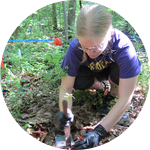About This Project
Biofuels could be a promising renewable, domestic alternative to fossil fuels, but their production depends on using food crops, which is wasteful. This research aims to improve biofuel production by identifying bacteria which can effectively strip lignin, a hard-to-break-down chemical, from the edible parts of plants. This would allow biofuels to be produced from plant waste, instead of food crops.Ask the Scientists
Join The DiscussionWhat is the context of this research?
According to BP's latest review of world energy, global oil demand has increased 18% over the past decade. Meanwhile, governments have started mandating that more energy be produced domestically from plant matter. In theory, these fuels should offer an opportunity for more local fuel production, increased rural employment, and reduced dependence on foreign oil.
Biofuel production from easily-digested plant parts such as corn kernels has made great progress during this time, and has become much more affordable. However, using edible plant parts for fuel production is of great debate, considering all the hungry souls out there. This process also creates a lot of waste material- imagine all the stems, husks, and leaves from the corn plants that are wasted. Our vision of the future is to utilize all of that waste material, instead of the food portion, to produce fuel. This would also reduce the farming resources required, because one corn crop could be used to produce both food and fuel, instead of one corn crop devoted to each.
The government has recognized this potential, and set ambitious goals to produce so-called "second-generation biofuels" from cellulose- the most abundant component of plant waste. But biofuel producers have fallen far short of these goals, and in 2012 the US Department of Energy reported that no second generation biofuel had been sold. Part of this is due to the "toughness" of the plant parts used.
Cellulose, the key target of these fuels, offers challenges of its own, given that fewer microbes are able to convert cellulose in corn stems, for example, than the starch in corn kernels, to ethanol. Large quantities of expensive enzymes are needed to complete this step, but perhaps more challenging is the lack of access these enzymes have to the cellulose in raw plant matter. That is because a complex compound- called lignin- physically prevents these enzymes from accessing the cellulose. Until recently, only a handful of relatively inefficient enzymes were known to break down lignin, and liberating the more desirable cellulose required intensive mechanical and chemical treatments which require huge energy inputs. If these harsh steps were instead completed by efficient enzymes, such as those recently identified in a bacterium isolated by our advisor from tropical forest soils, then we can produce better, affordable, more socially- and environmentally-responsible biofuels.
We'll need to understand how these bacteria break down lignin. That's the first step scaling this process and producing our own fuels.
What is the significance of this project?
Governments around the world are calling for increased, efficient biofuel production, but progress towards this goal is currently hindered by lack of microbes able to break down lignin.
We have previously isolated bacteria from soil samples that can grow when given lignin as the only source of carbon. Understanding how these microbes break down lignin into chemicals they can use will teach us how we can more efficiently mimic the process in biofuel production facilities. Efficiency means reduced costs, less waste, and a more socially and economically sustainable biofuels future.
What are the goals of the project?
In order to determine if the bacteria we have extracted from soil are in fact able to break down lignin, we will check for the ability to degrade lignin-like compounds using enzyme assays. After identifying bacteria with high enzyme activity, we will then look at the rate at which they break down "real" lignin in the absence of oxygen. Finally, we will perform proteomic analysis on the bacterium that demonstrates the greatest capacity for degrading lignin. With this information we can identify the specific enzymes responsible for breaking down lignin. As a stretch goal, we hope to sequence the entire genome of the chosen organism. We could then find the genes responsible for producing the lignin-degrading enzymes, which could then be used in the engineering of efficient biofuel production.
Budget
Money will be used to assess lignin-related enzyme activity for previously isolated bacteria capable of growth on lignin as the sole carbon source. We will then select the most active lignin degrader and analyze the enzymes used in the presence of lignin, using proteomic analysis. Proteomics will essentially involve identifying all the tools the bacteria use to survive in their environment in the presence and absence of lignin, and then figuring out which of these tools are specific to lignin. With additional funding, we would like to sequence the genome of the organism, by which we hope to identify the genes involved in lignin degradation, taking another step towards engineering an efficient biofuel production system.
Meet the Team
Team Bio
Andrew is a research fellow, and Grace is a master's student, both in Kristen DeAngelis' lab at UMass Amherst. The DeAngelis lab is on a mission to determine how environmental conditions affect how microorganisms break down the carbon in soil, with a particular emphasis on old, difficult to decompose chemicals.Andrew completed both his undergraduate and masters' studies in microbiology at UMass Amherst. Having done his graduate research on the subject, Andrew has experience characterizing bacteria able to degrade lignin in the absence of oxygen. In his spare time, he teaches and competes in ballroom dancing, on wood floors strengthened by lignin.
Grace completed her undergraduate in biology at McGill University in Montreal, but is now doing her masters' at UMass. Her research has resulted in a number of novel lignin-degrading isolates we hope to study in greater depth as part of this project. In her spare time, she likes baking things with vanilla, a product of lignin decomposition.
Grace Pold
I love microbes. Nuff said.
Additional Information
DeAngelis KM, Sharma D, Varney R, Simmons B, Isern NG, Markillie LM, Nicora C, Norbeck AD, Taylor RC, Aldrich JT and Robinson EW (2013) Evidence supporting dissimilatory and assimilatory lignin degradation in Enterobacter lignolyticus SCF1. Front. Microbiol. 4:280.doi: 10.3389/fmicb.2013.00280 BP Statistical Review of World Energy. June 2013.US Energy Information Adminstration. Biofuels Issues and Trends. October 2011 Report.
Lynn Yarris - Lignin-Feasting Microbe Holds Promise for Biofuels - LBNL News Center - Nov 13th 2013
Klein-Marcuschamer, D. and Blanch, H. W. (2013), Survival of the fittest: An economic perspective on the production of novel biofuels. AIChE J., 59: 4454–4460. doi: 10.1002/aic.14245
Project Backers
- 5Backers
- 15%Funded
- $260Total Donations
- $52.00Average Donation

